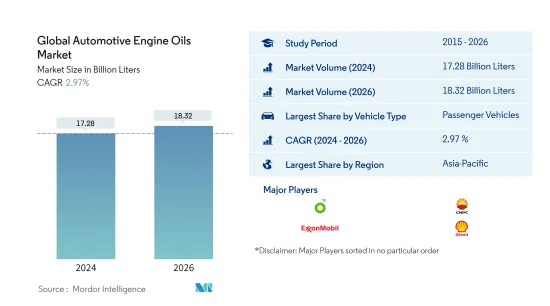Need help finding what you are looking for?
Contact Us
PUBLISHER: Mordor Intelligence | PRODUCT CODE: 1430953

PUBLISHER: Mordor Intelligence | PRODUCT CODE: 1430953
Global Automotive Engine Oils - Market Share Analysis, Industry Trends & Statistics, Growth Forecasts (2021 - 2026)
PUBLISHED:
PAGES: 80 Pages
DELIVERY TIME: 2-3 business days
SELECT AN OPTION
The Global Automotive Engine Oils Market size is estimated at 17.28 Billion Liters in 2024, and is expected to reach 18.32 Billion Liters by 2026, growing at a CAGR of 2.97% during the forecast period (2024-2026).

Key Highlights
- Largest Segment by Vehicle Type - Passenger Vehicles : The large fleet size of passenger vehicles across the globe has resulted in this sector accounting for the highest engine oil consumption among the various vehicle types.
- Fastest Segment by Vehicle Type - Motorcycles : The sales boost for motorcycles in several countries despite the COVID-19 pandemic is likely to continue and boost engine oil consumption by this sector in the future.
- Largest Regional Market - Asia-Pacific : Asia-Pacific is home to countries with large vehicle fleets like China, India & Indonesia. As a result, the engine oil consumption by this sector was highest in Asia-Pacific.
- Fastest Growing Regional Market - Asia-Pacific : The low penetration of synthetic oils and expected high growth rates of vehicle population in countries like India are likely to drive the lubricant consumption in APAC.
Automotive Engine Oils Market Trends
Largest Segment By Vehicle Type : Passenger Vehicles
- Engine oils are the most used automotive lubricants among all the product types. During 2015-2019, global automotive engine oil consumption increased at a CAGR of 2.5%. In 2020, engine oils accounted for around 78% of the total automotive lubricant consumption volume globally.
- In 2020, the COVID-19 outbreak resulted in a huge decline in the usage of the existing global vehicle fleet due to a reduction in business activities. As a result, the passenger vehicles and motorcycles segments witnessed the largest drop in engine oil consumption in 2020 compared to 2019.
- Along with the expected recovery in sales and production of motor vehicles, an increase in the penetration of electric vehicles is expected to impact engine oil consumption slightly. Therefore, due to such factors, engine oil consumption is expected to register a CAGR of 3.72% during 2021-2026.
Largest Region : Asia-Pacific
- During 2015-2019, the global automotive engine oil consumption increased at a CAGR of over 2%. During this period, Asia-Pacific was the leading consumer of automotive engine oils and accounted for around 43% of the global volume, followed by North America and Europe.
- The travel restrictions imposed after the COVID-19 outbreak restricted engine oil consumption in 2020. North America was the most affected region as it witnessed a 17.5% drop in consumption during 2019-2020, followed by Europe (a 15.8% drop).
- Asia-Pacific is expected to be the fastest-growing engine oil market as the consumption is anticipated to increase at a CAGR of 4.73%, followed by Africa and South America (with an expected CAGR of 4.07% and 2.97%, respectively), during 2021-2026. The expected recovery in automotive sales and production from 2022 will likely drive this growth.
Automotive Engine Oils Industry Overview
The Global Automotive Engine Oils Market is moderately consolidated, with the top five companies occupying 40.16%. The major players in this market are BP PLC (Castrol), China National Petroleum Corporation, ExxonMobil Corporation, Royal Dutch Shell PLC and TotalEnergies (sorted alphabetically).
Additional Benefits:
- The market estimate (ME) sheet in Excel format
- 3 months of analyst support
Product Code: 90301
TABLE OF CONTENTS
1 Executive Summary & Key Findings
2 Introduction
- 2.1 Study Assumptions & Market Definition
- 2.2 Scope of the Study
- 2.3 Research Methodology
3 Key Industry Trends
- 3.1 Automotive Industry Trends
- 3.2 Regulatory Framework
- 3.3 Value Chain & Distribution Channel Analysis
4 Market Segmentation
- 4.1 By Vehicle Type
- 4.1.1 Commercial Vehicles
- 4.1.2 Motorcycles
- 4.1.3 Passenger Vehicles
- 4.2 By Product Grade
- 4.3 By Region
- 4.3.1 Africa
- 4.3.1.1 Egypt
- 4.3.1.2 Morocco
- 4.3.1.3 Nigeria
- 4.3.1.4 South Africa
- 4.3.1.5 Rest of Africa
- 4.3.2 Asia-Pacific
- 4.3.2.1 China
- 4.3.2.2 India
- 4.3.2.3 Indonesia
- 4.3.2.4 Japan
- 4.3.2.5 Malaysia
- 4.3.2.6 Philippines
- 4.3.2.7 Singapore
- 4.3.2.8 South Korea
- 4.3.2.9 Thailand
- 4.3.2.10 Vietnam
- 4.3.2.11 Rest of Asia-Pacific
- 4.3.3 Europe
- 4.3.3.1 Bulgaria
- 4.3.3.2 France
- 4.3.3.3 Germany
- 4.3.3.4 Italy
- 4.3.3.5 Norway
- 4.3.3.6 Poland
- 4.3.3.7 Russia
- 4.3.3.8 Spain
- 4.3.3.9 United Kingdom
- 4.3.3.10 Rest of Europe
- 4.3.4 Middle East
- 4.3.4.1 Iran
- 4.3.4.2 Qatar
- 4.3.4.3 Saudi Arabia
- 4.3.4.4 Turkey
- 4.3.4.5 UAE
- 4.3.4.6 Rest of Middle East
- 4.3.5 North America
- 4.3.5.1 Canada
- 4.3.5.2 Mexico
- 4.3.5.3 United States
- 4.3.5.4 Rest of North America
- 4.3.6 South America
- 4.3.6.1 Argentina
- 4.3.6.2 Brazil
- 4.3.6.3 Colombia
- 4.3.6.4 Rest of South America
- 4.3.1 Africa
5 Competitive Landscape
- 5.1 Key Strategic Moves
- 5.2 Market Share Analysis
- 5.3 Company Profiles
- 5.3.1 BP PLC (Castrol)
- 5.3.2 Chevron Corporation
- 5.3.3 China National Petroleum Corporation
- 5.3.4 China Petroleum & Chemical Corporation
- 5.3.5 ENEOS Corporation
- 5.3.6 ExxonMobil Corporation
- 5.3.7 Idemitsu Kosan Co. Ltd
- 5.3.8 Royal Dutch Shell PLC
- 5.3.9 TotalEnergies
- 5.3.10 Valvoline Inc.
6 Appendix
- 6.1 Appendix-1 References
- 6.2 Appendix-2 List of Tables & Figures
7 Key Strategic Questions for Lubricants CEOs
Have a question?


SELECT AN OPTION
Have a question?


Questions? Please give us a call or visit the contact form.
